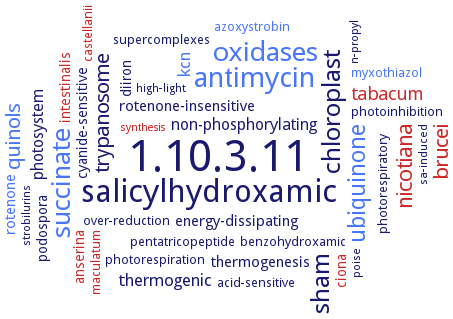1.10.3.11: ubiquinol oxidase (non-electrogenic)
This is an abbreviated version!
For detailed information about ubiquinol oxidase (non-electrogenic), go to the full flat file.

Word Map on EC 1.10.3.11 
-
1.10.3.11
-
salicylhydroxamic
-
antimycin
-
oxidases
-
succinate
-
chloroplast
-
sham
-
ubiquinone
-
nicotiana
-
quinols
-
trypanosome
-
brucei
-
tabacum
-
kcn
-
thermogenic
-
non-phosphorylating
-
photosystem
-
rotenone-insensitive
-
energy-dissipating
-
thermogenesis
-
rotenone
-
intestinalis
-
podospora
-
cyanide-sensitive
-
diiron
-
ciona
-
anserina
-
myxothiazol
-
maculatum
-
pentatricopeptide
-
benzohydroxamic
-
acid-sensitive
-
supercomplexes
-
over-reduction
-
photorespiration
-
photoinhibition
-
photorespiratory
-
azoxystrobin
-
castellanii
-
poise
-
sa-induced
-
strobilurins
-
high-light
-
n-propyl
-
synthesis
- 1.10.3.11
-
salicylhydroxamic
- antimycin
- oxidases
- succinate
- chloroplast
-
sham
- ubiquinone
- nicotiana
- quinols
-
trypanosome
- brucei
- tabacum
- kcn
-
thermogenic
-
non-phosphorylating
-
photosystem
-
rotenone-insensitive
-
energy-dissipating
-
thermogenesis
- rotenone
- intestinalis
-
podospora
-
cyanide-sensitive
-
diiron
- ciona
- anserina
- myxothiazol
- maculatum
-
pentatricopeptide
-
benzohydroxamic
-
acid-sensitive
-
supercomplexes
-
over-reduction
-
photorespiration
-
photoinhibition
-
photorespiratory
- azoxystrobin
- castellanii
-
poise
-
sa-induced
-
strobilurins
-
high-light
-
n-propyl
- synthesis
Reaction
2 ubiquinol
+
Synonyms
alternative oxidase, alternative oxidase 1a, alternative oxidase 1b, alternative oxidases, AOX, AOX1, AOX1a, AOX1b, AOX1C, AOX1D, AOX2, AOX2b, AOX2b1, AOX3, AppBC, AtAOX1A, CIO, CioAB, Cox2, CrAOX1, CrAOX2, cyanide-insensitive alternative oxidase, cyanide-insensitive oxidase, cyanide-insensitive quinol oxidase, cyanide-insensitive terminal quinol oxidase, cyanide-resistant alternative oxidase, cyanide-resistant bd-type ubiquinol oxidase, cyanide-resistant oxidase, cyanide-resistant ubiquinol oxidase, CydA, CydB, cytochrome ba3 oxidase, cytochrome bb3 oxidase, cytochrome bd-II, cytochrome bd-type quinol oxidase, cytochrome bo3, cytochrome bo3 ubiquinol oxidase, heme-copper terminal oxidase, mitochondrial alternative oxidase, MpAOX, plant alternative oxidase, TAO, TAOX, trypanosomal alternative oxidase, ubiquinol:oxygen oxidoreductase


 results (
results ( results (
results ( top
top





